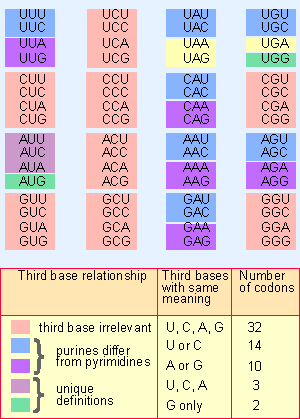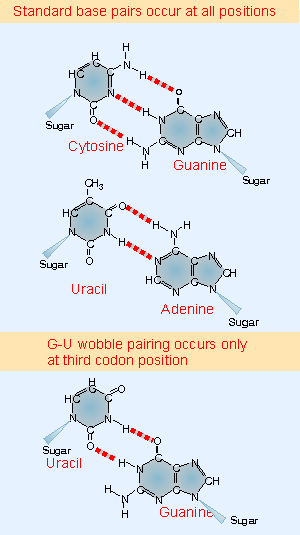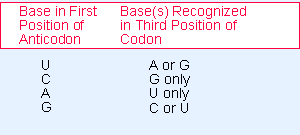2. Codon-anticodon recognition involves wobbling
7.2 Codon-anticodon recognition involves wobbling |
| Key terms defined in this section |
| Wobble hypothesis accounts for the ability of a tRNA to recognize more than one codon by unusual (non-G PC, non-A PT) pairing with the third base of a codon. |
The function of tRNA in protein synthesis is fulfilled when it recognizes the codon in the ribosomal A site. The interaction between anticodon and codon takes place by base pairing, but under rules that extend pairing beyond the usual G PC and A PU partnerships.
We can deduce the rules governing the interaction from the sequences of the anticodons that correspond to particular codons. The ability of any tRNA to respond to a given codon can be measured directly by the trinucleotide binding assay or by its use in an in vitro protein synthetic system.
 |
Figure 7.3 Third bases have the least influence on codon meanings. Boxes indicate groups of codons within which third-base degeneracy ensures that the meaning is the same. |
The genetic code itself yields some important clues about the process of codon recognition. The pattern of third-base degeneracy is drawn in Figure 7.3, which shows that in almost all cases either the third base is irrelevant or a distinction is made only between purines and pyrimidines.
There are eight codon families in which all four codons sharing the same first two bases have the same meaning, so that the third base has no role at all in specifying the amino acid. There are seven codon pairs in which the meaning is the same whichever pyrimidine is present at the third position; and there are five codon pairs in which either purine may be present without changing the amino acid that is coded.
There are only three cases in which a unique meaning is conferred by the presence of a particular base at the third position: AUG (for methionine), UGG (for tryptophan), and UGA (termination). So C and U never have a unique meaning in the third position, and A never signifies a unique amino acid.
Because the anticodon is complementary to the codon, it is the first base in the anticodon sequence written conventionally in the direction from 5′ to 3′ that pairs with the third base in the codon sequence written by the same convention. So the combination
Codon 5′ A C G 3′
Anticodon 3′ U G C 5′
is usually written as codon ACG/anticodon CGU, where the anticodon sequence must be read backward for complementarity with the codon.
To avoid confusion, we shall retain the usual convention in which all sequences are written 5′ V3′, but indicate anticodon sequences with a backward arrow as a reminder of the relationship with the codon. So the codon/anticodon pair shown above will be written as ACG and CGU←, respectively.
Does each triplet codon demand its own tRNA with a complementary anticodon? Or can a single tRNA respond to both members of a codon pair and to all (or at least some) of the four members of a codon family?
Often one tRNA can recognize more than one codon. This means that the base in the first position of the anticodon must be able to partner alternative bases in the corresponding third position of the codon. Base pairing at this position cannot be limited to the usual G PC and A PU partnerships.
 |
Figure 7.4 Wobble in base pairing allows G-U pairs to form between the third base of the codon and and the first base of the anticodon. |
The rules governing the recognition patterns are summarized in the wobble hypothesis, which states that the pairing between codon and anticodon at the first two codon positions always follows the usual rules, but that exceptional "wobbles" occur at the third position. Wobbling occurs because the conformation of the tRNA anticodon loop permits flexibility at the first base of the anticodon (449). Figure 7.4 shows that G PU pairs can form in addition to the usual pairs.
 |
Figure 7.5 Codon-anticodon pairing involves wobbling at the third position. |
This single change creates a pattern of base pairing in which A can no longer have a unique meaning in the codon (because the U that recognizes it must also recognize G). Similarly, C also no longer has a unique meaning (because the G that recognizes it also must recognize U). Figure 7.5 summarizes the pattern of recognition.
It is therefore possible to recognize unique codons only when the third bases are G or U; this option is not used often, since UGG and AUG are the only examples of the first type, and there is none of the second type.
(G PU pairs are common in RNA duplex structures. But the formation of stable contacts between codon and anticodon, when only 3 base pairs can be formed, is more constrained, and thus G PU pairs can contribute only in the last position of the codon.)
| Research | |
| 449: | Crick, F. H. C. (1966). Codon-anticodon pairing: the wobble hypothesis. J. Mol. Biol. 19, 548-555. |